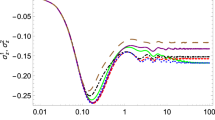Abstract
We discuss the question of the general definition of the production of entropy per unit time for a quantum system governed by the Lindblad equation. The difficulty is as follows: in order to determine the total production of entropy, one must know the entropy flow from the system into the environment. This requires additional information on the environment and on its interaction with the system. The Lindblad equation for the reduced density matrix of the system does not contain such information. Therefore, the following question arises: What minimum additional information about the environment must be added to the Lindblad equation in order to find the flow of entropy into the environment and the total production of entropy? To answer this question, we use the concept of a complementary quantum channel known from the the quantum information theory. We also prove a theorem on the nonnegativity of production of entropy, and, under certain assumptions, the adiabatic and nonadiabatic contribution to it.
Similar content being viewed by others
References
L. Accardi and S. V. Kozyrev, “Coherent population trapping in the stochastic limit,” Int. J. Theor. Phys., 45, No. 4, 661–668 (2006).
L. Accardi, Y. G. Lu, and I. Volovich, Quantum Theory and Its Stochastic Limit, Springer-Verlag, Berlin (2002).
I. Ya. Aref’eva, I. V. Volovich, and S. V. Kozyrev, “Stochastic limit method and interference in quantum many-particle systems,” Teor. Mat. Fiz, 183, No. 3, 388–408 (2015).
F. Barra, “The thermodynamic cost of driving quantum systems by their boundaries,” Sci. Rep., 5, 14873 (2015).
H.-P. Breuer and F. Petruccione, Theory of Open Quantum Systems, Oxford (2002).
E. Davies, “Markovian master equations,” Commun. Math. Phys., 39, 91–110 (1974).
I. Devetak and P. Shor, “The capacity of a quantum channel for simultaneous transmission of classical and quantum information,” Commun. Math. Phys., 256, No. 2, 287–303 (2005).
M. Esposito, K. Lindenberg, and C. Van den Broek, “Entropy production as correlation between system and reservoir,” New J. Phys., 12, 013013 (2010).
M. Esposito and C. Van den Broeck, “Three faces of the second law. I. Master equation formulation,” Phys. Rev. E, 82, No. 1, 011143 (2010).
F. Fagnola and V. Umanità, “Generators of detailed balance quantum Markov semigroups,” Inf. Dim. Anal. Quantum Prob. Rel. Top., 10, 335–363 (2007).
V. Gorini, A. Kossakowski, and E. C. G. Sudarshan, “Completely positive dynamical semigroups of N-level systems,” J. Math. Phys., 17, 821–825 (1976).
R. J. Harris and G. M. Schütz, “Fluctuation theorems for stochastic dynamics,” J. Stat. Mech., 7, P07020 (2007).
T. Hatano and S. Sasa, “Steady-state thermodynamics of Langevin systems,” Phys. Rev. Lett., 86, No. 16, 3463–3466 (2001).
A. S. Holevo, “Complementary channels and the problem of additivity,” Theory Probab. Appl., 51, No. 1, 133–143 (2006).
A. S. Holevo, Quantum Systems, Channels, Information [in Russian], MCCME, Moscow (2010).
J. M. Horowitz and M. R. Parrondo, “Entropy production along nonequilibrium quantum jump trajectories,” New J. Phys., 15, 085028 (2013).
J. M. Horowitz and T. Sagawa, “Equivalent definitions of the quantum nonadiabatic entropy production,” J. Stat. Phys., 156, No. 1, 55–65 (2014).
A. Levy and R. Kosloff, “The local approach to quantum transport may violate the second law f thermodynamics,” Europhys. Lett., 107, No. 2, 20004 (2014).
G. Lindblad, “On the generators of quantum dynamical semigroups,” Commun. Math. Phys., 48, 119–130 (1976).
I. A. Luchnikov and S. N. Filippov, Stroboscopic limit of sequential measurements, e-print arxiv.org/abs/1609.05501.
M. Ohya and I. Volovich, Mathematical Foundations of Quantum Information and Computation and Its Applications to Nano- and Biosystems, Springer-Verlag, Dordrecht (2011).
Y. Oono and M. Paniconi, “Steady state thermodynamics,” Progr. Theor. Phys. Suppl., 130, 29–44 (1997).
A. Pechen’, “Engineering arbitrary pure and mixed quantum states,” Phys. Rev. A, 84, No. 6, 042106 (2011).
A. N. Pechen’ and N. B. Il’in, “On the problem of maximizing the probability of transition in n-level quantum system by means of nonselective measurements,” Tr. Mat. Inst. Steklova, 294, 248–255 (2016).
A. Pechen’, N. Ilin, F. Shuang, and H. Rabitz, “Quantum control by von Neumann measurements,” Phys. Rev. A, 74, No. 5, 052102 (2006).
A. Pechen’ and H. Rabitz, “Teaching the environment to control quantum systems,” Phys. Rev. A, 73, No. 4, 062102 (2006).
A. Pechen’ and A. Trushechkin, “Measurement-assisted Landau–Zener transitions,” Phys. Rev. A, 91, No. 5, 052316 (2015).
J. Sakurai, Modern Quantum Mechanics, Addison-Wesley, New York (2004).
F. Shuang, A. Pechen’, T.-S. Ho, and H. Rabitz, “Observation-assisted optimal control of quantum dynamics,” J. Chem. Phys., 126, No. 13, 134303 (2007).
H. Spohn, “Entropy production for quantum dynamical semigroups,” J. Math. Phys., 19, No. 5, 1227–1230 (1978).
H. Spohn and J. L. Lebowitz, “Irreversible thermodynamics for quantum systems weakly coupled to thermal reservoirs,” Adv. Chem. Phys., 38, 109–142 (1978).
A. S. Trushechkin and I. V. Volovich, “Perturbative treatment of inter-site couplings in the local description of open quantum networks,” Europhys. Lett., 113, No. 3, 30005 (2016).
I. V. Volovich and S. V. Kozyrev, “Manipulation of states of a degenerate quantum system,” Tr. Mat. Inst. Steklova, 294, 256–267 (2016).
S. Yukawa, The second law of steady state thermodynamics for nonequilibrium quantum dynamics, e-print arxiv.org/abs/cond-mat/0108421.
Author information
Authors and Affiliations
Corresponding author
Additional information
Translated from Itogi Nauki i Tekhniki, Seriya Sovremennaya Matematika i Ee Prilozheniya. Tematicheskie Obzory, Vol. 138, Quantum Computing, 2017.
Rights and permissions
About this article
Cite this article
Trushechkin, A.S. On the General Definition of the Production of Entropy in Open Markov Quantum Systems. J Math Sci 241, 191–209 (2019). https://doi.org/10.1007/s10958-019-04417-4
Published:
Issue Date:
DOI: https://doi.org/10.1007/s10958-019-04417-4




